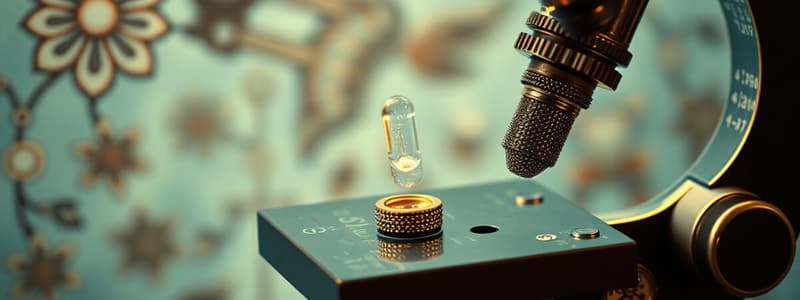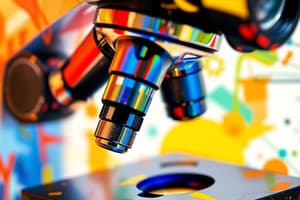Podcast
Questions and Answers
What does the term 'micro' in microscope refer to?
What does the term 'micro' in microscope refer to?
- To make large
- To change color
- To see small (correct)
- To view an object
Which statement accurately describes the function of a microscope?
Which statement accurately describes the function of a microscope?
- To create reflected images of large objects
- To analyze chemical properties of materials
- To magnify objects for better visibility (correct)
- To illuminate objects with lasers
What processes do the different parts of a microscope facilitate?
What processes do the different parts of a microscope facilitate?
- Changing the color of the sample
- Performing chemical reactions on samples
- Magnifying and clarifying images (correct)
- Infrared imaging of samples
What is true about the structures that can be examined with a microscope?
What is true about the structures that can be examined with a microscope?
What combination of words forms the term 'microscope'?
What combination of words forms the term 'microscope'?
What is a common use for the light microscope in the laboratory?
What is a common use for the light microscope in the laboratory?
Why is the light microscope referred to as a compound microscope?
Why is the light microscope referred to as a compound microscope?
Which components primarily contribute to the functioning of a compound microscope?
Which components primarily contribute to the functioning of a compound microscope?
What is NOT a typical feature of a light microscope?
What is NOT a typical feature of a light microscope?
In what scenario would a light microscope be most appropriately used?
In what scenario would a light microscope be most appropriately used?
What is the function of the eyepiece in a light microscope?
What is the function of the eyepiece in a light microscope?
Which part of the light microscope connects the eyepiece to the objectives?
Which part of the light microscope connects the eyepiece to the objectives?
How many objective lenses are typically found in a compound light microscope?
How many objective lenses are typically found in a compound light microscope?
What is the purpose of the nosepiece in a light microscope?
What is the purpose of the nosepiece in a light microscope?
Which of the following is NOT an objective lens found in a compound light microscope?
Which of the following is NOT an objective lens found in a compound light microscope?
What is the lowest magnification power of the objective lenses in a compound light microscope?
What is the lowest magnification power of the objective lenses in a compound light microscope?
What is the total magnification achieved if the eyepiece magnification is 10× and the objective lens magnification is 4×?
What is the total magnification achieved if the eyepiece magnification is 10× and the objective lens magnification is 4×?
Which part of the microscope is primarily responsible for supporting the body tube?
Which part of the microscope is primarily responsible for supporting the body tube?
What is the primary function of the coarse adjustment knob in a microscope?
What is the primary function of the coarse adjustment knob in a microscope?
In a microscope, what is the purpose of the fine adjustment knob?
In a microscope, what is the purpose of the fine adjustment knob?
Where is the specimen slide placed for viewing in a microscope?
Where is the specimen slide placed for viewing in a microscope?
If a microscope has an ocular lens that magnifies 10 times and an objective lens that magnifies 100 times, what is the total magnification?
If a microscope has an ocular lens that magnifies 10 times and an objective lens that magnifies 100 times, what is the total magnification?
Flashcards
Microscope
Microscope
An instrument magnifying very small objects invisible to the naked eye by using lenses and light.
Objective lens
Objective lens
The part that magnifies the object under observation.
Eyepiece
Eyepiece
The lens closest to your eye, which further magnifies the image from the objective lens.
Stage
Stage
Signup and view all the flashcards
Illuminator
Illuminator
Signup and view all the flashcards
Light Microscope
Light Microscope
Signup and view all the flashcards
Compound Microscope
Compound Microscope
Signup and view all the flashcards
Light Microscope
Light Microscope
Signup and view all the flashcards
Microscopic Organisms
Microscopic Organisms
Signup and view all the flashcards
Microscopic Study
Microscopic Study
Signup and view all the flashcards
Body Tube
Body Tube
Signup and view all the flashcards
Nosepiece
Nosepiece
Signup and view all the flashcards
Scanning Lens (4X)
Scanning Lens (4X)
Signup and view all the flashcards
Low-Power Lens (10X)
Low-Power Lens (10X)
Signup and view all the flashcards
Microscope arm
Microscope arm
Signup and view all the flashcards
Coarse adjustment knob
Coarse adjustment knob
Signup and view all the flashcards
Fine adjustment knob
Fine adjustment knob
Signup and view all the flashcards
Total Magnification
Total Magnification
Signup and view all the flashcards
Study Notes
Microscope Parts & Uses
- A microscope is an instrument that uses visible light and magnifying lenses to examine small objects
- The word "microscope" combines "micro" (small) and "scope" (view)
- Light microscopes are used in laboratories for diagnosing and studying microscopic organisms
- A compound light microscope has two types of lenses that magnify an object:
- Eyepiece: the lens closest to the eye
- Objective: the lens closest to the specimen
- Total magnification is calculated by multiplying the magnification of the eyepiece by the magnification of the objective lens
- Eyepiece: Used for looking through to see the image of the specimen
- Body tube: A long tube that holds the eyepiece and connects it to the objectives
- Nosepiece: Rotates to change the objective lenses
- Objective lenses: Come in different magnifications:
- Scanning (4X)
- Low-power (10X)
- High-power (40X)
- Oil-immersion (100X)
- Stage: Large, flat area where the specimen slide is placed
- Stage clips: Hold the slide in place on the stage
- Aperture: A hole in the stage that allows light through for viewing
- Condenser: Collects, controls, and concentrates light from the lamp to the specimen
- Diaphragm control: Regulates the amount of light passing through the aperture
- Light source: Usually located at the base of the microscope; makes the specimen easier to see
- Coarse Adjustment Knob: Large knob used to initially focus the specimen
- Fine Adjustment Knob: Small knob for precise focusing after using the coarse adjustment knob
- Arm: Supports the body tube and is attached to the foot
- Base: Supports the entire microscope
- Microscope uses: Botanical, biological, crime investigation, educational, and medical fields
Studying That Suits You
Use AI to generate personalized quizzes and flashcards to suit your learning preferences.




